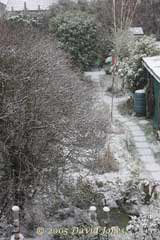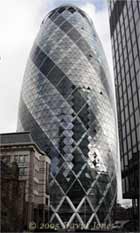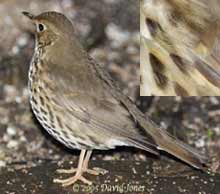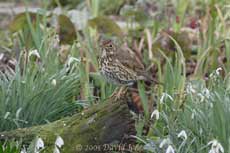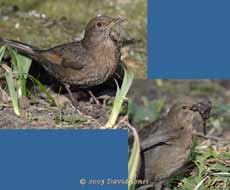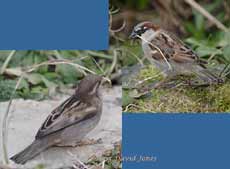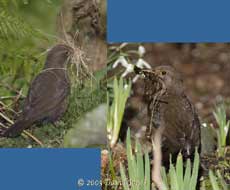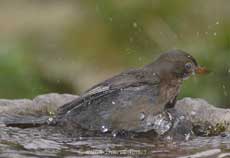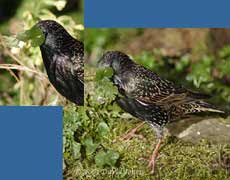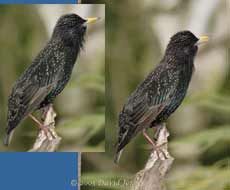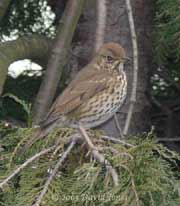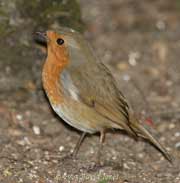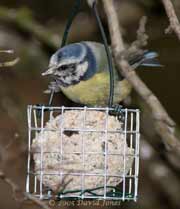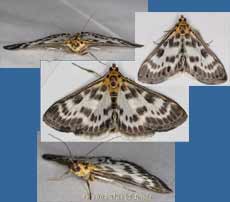Go to latest entry of the month ......Go to previous entry4 March - Getting anything done has been difficult the last few days, which is why I've been a bit slow to get this chapter started.
It had been a cold night with temperatures below 0C, so that the ponds and bird bath were frozen over. There was no snow when I went out to pour hot water on the bath shortly before 8am. Then the snow started and it looked as though we were going to get a decent fall. I had to head for London during the morning (more later). Sadly, by the time I was heading for the railway station the snow had not only stopped, but it was already being replaced by rain. Within a few stations there was virtually no sign of snow, and central London was cold but snow free.
I took my camera with me as the London trip was to collect a telephoto lens that I have just bought on eBay. I had hoped to spend some time taking some 'tourist' pictures but I became too tired too soon. I did, however, manage this shot of what is known as the 'Gherkin', a building designed by Sir Norman Foster, and which I had previously only seen from a distance. It provides an interesting contrast to the more conventional buildings around it and a more drastic one to the nearby Lloyds Building with its very 'industrial' external pipe work etc
By the time I got home it was getting a bit late to put it to a real test in the garden. However, I did manage to grab this image of the Song Thrush through the double glazed window. The insert in the top right corner shows an enlarged area of the photograph showing the individual filaments of the feathers - a degree of sharpness that had escaped me up to now for shots like this.
The lens will be spending a lot of time attached to my camera (and will probably be the last lens I will buy!).
5 March - The weather continues to play tricks. A thin layer of ice first thing and then about a minute of huge snowflakes which disappeared immediately. In the meantime, the female Blackbird has started nest building, although I don't think it's in our garden. She has been collecting materials from between the ponds. I tried to get a photograph today, but she didn't appear while I was watching. I'll try again tomorrow.
In contrast I noticed the first flower buds on a Lesser Cellandine plant. I shall check it again tomorrow. Next to the big pond the Snake's-head Fritillary plants have started to appear.
6 March - Another cold start with frozen over ponds and birthbath. However, on a sunny day, with almost cloudless skies most of the ice had disappeared by noon.
She favours the area behind the small pond for the finer, dry materials, which seem to be roots that she pulls off the spreading Flag Iris rhyzomes. She heads to the Irises in the small pond itself for the wet materials. Unfortunately, she normally took off directly from behind the Irises so the slightly out of focus right hand image is the only one I managed to get that show her leaving with these.
The sparrow in the left hand image was determined to fly off with that grass stem even though it was still attached. It must have tried six times before choosing another, more available piece. Also, unlike the Blackbirds, where only the female does the building, there were a couple of male Sparrows collecting as well.
7 March - Another frosty start to a cloudy day, although the forecasters promise no more before the end of the week.
There is still no interest being shown in the birdbox, the Song Thrush continues to make frequent visits to feed, and the Blackbird continues her nest building, and like yesterday, there were sessions when she collected dry and wet materials. She hasn't yet started to collect moss, so I guess we will see more activity tomorrow.
These activities come to a stop by lunchtime, although she still visits to feed throughout the afternoon. Nest building must be dirty work - she made use of the bird bath several times during the day, even though the ice cover on the pond had long gone.
I spent some time in the caravan again, hoping to get more photographs of the Sparrows. I saw just a couple of them gathering straw but I obviously left it too late to catch them. However, this Starling did turn up at the side of the big pond, and started tearing off pieces of leaf which it flew off with. While Starlings in the garden happily eat the fatballs, apples, pears, peanuts and raisins I can't recall ever seeing this before. Of course, it may be nest building, but I thought they only used dry straw etc.
Finally, just when I thought we had lost the Dunnocks I spotted one making a brief visit to under the Hawthorn. 8 March - A dull, dry, ice free day with the temperature getting over 7C this afternoon.
It stayed there for some twenty minutes, singing its sub-song, which can be very musical at times. When the sound frequencies are lowest its throat feathers become raised as in the left hand image. To bring these pictures to life I should really have recorded the song! This was an opportunity to test the new lens with a x2 converter added - not bad, and I can't wait for one of the woodpeckers to visit the feeder so I can use the same combination on that.
Its perch is about 90ft or so from the bedroom window (twice the distance of the feeder) and I was quite surprised at how much effect the flashgun had at that distance. The image is cropped quite a bit and its lack of sharpness may be down partly to the fact that the trees were in constant movement due to the breeze blowing at the time, or a bit of camera shake as the 960mm equivalent lens was just resting on the window frame rather than secured on a tripod. I don't think I have ever seen a Thrush down in the garden as much as it is at present. I must have seen it here a couple of dozen times today. I forgot to mention yesterday that I saw a Goldcrest visit the peanut feeder briefly, and also caught a brief view of a Wren. The Wren made a longer appearance today, spending time hunting around the small pond. I was talking on the telephone at the time so there was no chance of a photograph today. The Blackbird was busy again this morning - it looked as though she was only interested in dry materials, and I didn't see her take any moss. Also there was a short session during which a number of Sparrows collected straw, and a Magpie took a couple of twigs from my neighbour's Birch tree.
9 March - Another mainly dull day with temperatures over 8C. Other than cleaning the thistle seed feeders, I have done nothing in the garden today, although we have been to a couple of places to look at what Rowan trees are available - I would like to plant one part the way down the garden. The Blackbird continues to gather dry material, and the Sparrows seemed to be busier today. This evening, an item on the uk.rec.birdwatching newsgroup spurred me to search for some photographs I took, back in 1974, of Humming Birds nesting in the Bahamas. I found some of them and used my camera to digitise them so that I can put them onto a web page which you can see in a new window if you click here. It was done in a hurry, so the images are rather dusty. I know it's impossible, but I would love to see Humming Birds in the garden! 11 March - The last two days have seen more mild temperatures - today it was up to 10C, and bird activity has been relatively low. I did notice a Blackbird gathering straw again, in the late afternoon for a change. With our nestbox continuing to stay quiet, I was interested this week to learn of another Blue Tit nestbox Diary that has been set up this Spring. A very good looking site, it has been set up by Andy and Jane in Farnham Surrey, just a few miles from here. They have already got Blue Tits coming and going, and it looks very promising. You can find it here.
12 March - Another day without pictures, I'm afraid, but a couple of things to note - Today was colder again, 3C at 8am, climbing to 8C by late afternoon, and cloudy with a few sunny spells and a chilly Northerly breeze. The Song Thrush pair were here again, with quiet a few visits individually as well, an a Dunnock made a couple of appearances. I didn't see any birds gathering nesting materials today. Recently I have been lamenting the lack of Blackcaps here this year. Well, I can just about claim one today - a Male Blackcap spent ages in my neighbour's Privet bush and on the conifers beyond the bottom of the garden, and several times it was on branches that overhang the garden. I'll be watching for it again over the days to come, and there are apples and a pear hanging from the Hawthorn ready for it.
13 March - A promised sunny day has failed to materialise. It started off bright, but the clouds soon took over. No Blackcap yet, but we had both Thrushes down together again this morning, although not close enough to photograph.
I did get this Robin picture. The white feather on the top of its head identifies it as the male that I photographed a number of times last April/May. Hopefully, its partner will choose to nest in the garden again this year. It has been visiting the bird table over the last few days.
Following a e-mail discussion about the dangers of the green nets around fat balls, I've made up several holders with steel mesh and garden wire. It wasn't long before Starlings and Blue Tits were happily using them. This is one of the BTs that is visiting my neighbour's birdbox.
15 March - A cloudy day with the temperature at 10C, and forecast to rise during the rest of the week.
I'm a bit puzzled why I cannot find another reference to it in my diaries. I have come across these numerous times when on holiday in Cornwall, but not in our garden. According to my guides they survive the winter as caterpillars in a cocoon under bark or in hollow stems, and then pupate in the Spring to emerge as adults in June and July.
With the prospect of Spring arriving there has been a timely item on the TV news today about The Harlequin Ladybird Survey being undertaken this year. Last year I saw the largest number of ladybird species yet in the garden, but the arrival of this invasive species could put that variety in real jeopardy. The distribution map on the survey site suggests that our garden is on the edge of the main area of spread so far. Watching out for Harlequin Ladybirds will be a priority from this year onwards. click on images to see larger versions |
|
